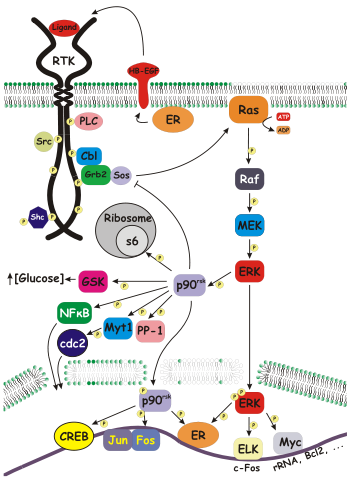Ribosomal s6 kinase

In molecular biology, ribosomal s6 kinase (rsk) is a family of protein kinases involved in signal transduction. There are two subfamilies of rsk, p90rsk, also known as MAPK-activated protein kinase-1 (MAPKAP-K1), and p70rsk, also known as S6-H1 Kinase or simply S6 Kinase. There are three variants of p90rsk in humans, rsk 1-3. Rsks are serine/threonine kinases and are activated by the MAPK/ERK pathway. There are two known mammalian homologues of S6 Kinase: S6K1 and S6K2.
Substrates
Both p90 and p70 Rsk phosphorylate
RSK phosphorylation of SOS1 (
p90rsk also regulates
Genomics
p90 Rsk-1 is located at 1p.[3]
p90 Rsk-2 is located at Xp22.2 and contains 22 exons. Mutations in this gene have been associated with Coffin–Lowry syndrome, a disease characterised by severe psychomotor retardation and other developmental abnormalities.[4]
p90 Rsk-3 is located at 6q27.[5]
Proteomics
The main distinguishing feature between p90rsk and p70rsk is that the 90 kDa family contain two non-identical kinase domains, while the 70 kDa family contain only one kinase domain.

Research history
Rsk was first identified in Xenopus laevis eggs by Erikson and Maller in 1985.[7]
References
External links
- Ribosomal+Protein+S6+Kinases,+90-kDa at the U.S. National Library of Medicine Medical Subject Headings (MeSH)
- Ribosomal+Protein+S6+Kinases,+70-kDa at the U.S. National Library of Medicine Medical Subject Headings (MeSH)
